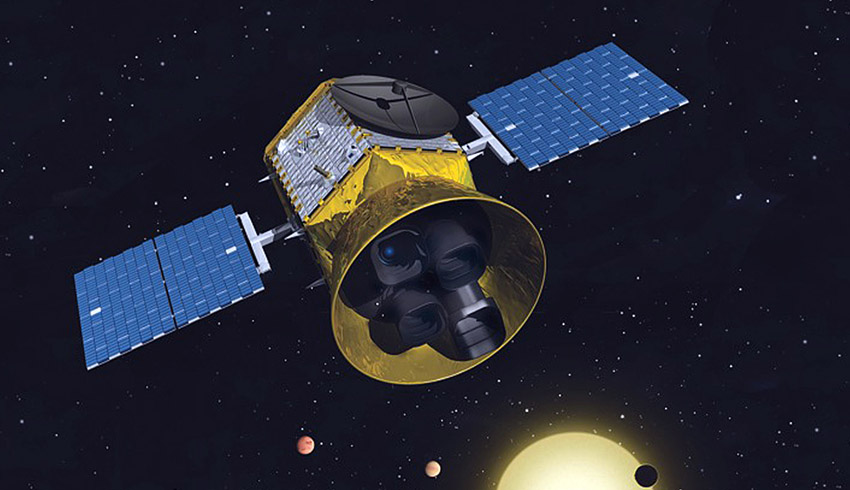
Now scientists using data from NASA's Transiting Exoplanet Survey Satellite (TESS) and retired Spitzer Space Telescope report the discovery of a planet about as large as Neptune that circles the young star in just over a week.
The system, known as AU Mic for short, provides a one-of-kind laboratory for studying how planets and their atmospheres form, evolve and interact with their stars.
Bryson Cale, a doctoral student at George Mason University in Fairfax, Virginia, said, "AU Mic is a young, nearby M dwarf star. It's surrounded by a vast debris disk in which moving clumps of dust have been tracked, and now, thanks to TESS and Spitzer, it has a planet with a direct size measurement. There is no other known system that checks all of these important boxes."
The new planet, AU Mic b, is described in a paper coauthored by Cale and led by his adviser Peter Plavchan, an assistant professor of physics and astronomy at George Mason. Their report was published on Wednesday, 24 June in the journal Nature.
AU Mic b is featured in a new NASA poster available in English and Spanish, part of a Galaxy of Horrors series. The fun but informative series resulted from a collaboration of scientists and artists and was produced by NASA's Exoplanet Exploration Program Office.
AU Mic is a cool red dwarf star with an age estimated at 20 million to 30 million years, making it a stellar infant compared with our sun, which is at least 150 times older.
The star is so young that it primarily shines from the heat generated as its own gravity pulls it inward and compresses it. Less than 10 per cent of the star's energy comes from the fusion of hydrogen into helium in its core, the process that powers stars like our sun.
The system is located 31.9 light years away in the southern constellation Microscopium. It's part of a nearby collection of stars called the Beta Pictoris Moving Group, which takes its name from a bigger, hotter A-type star that harbours two planets and is likewise surrounded by a debris disk.
Although the systems have the same age, their planets are markedly different. The planet AU Mic b almost hugs its star, completing an orbit every 8.5 days.
It mass is less than 58 times the Earth's, placing it in the category of Neptune-like worlds. Beta Pictoris b and c, however, are both at least 50 times more massive than AU Mic b and take 21 and 3.3 years, respectively, to orbit their star.
Thomas Barclay, an associate research scientist at the University of Maryland, Baltimore County, and an associate project scientist for TESS at NASA's Goddard Space Flight Center in Greenbelt, Maryland, explained, "We think AU Mic b formed far from the star and migrated inward to its current orbit, something that can happen as planets interact gravitationally with a gas disk or with other planets."
Detecting planets around stars like AU Mic poses a particular challenge. These stormy stars possess strong magnetic fields and can be covered with starspots – cooler, darker and highly magnetic regions akin to sunspots – that frequently erupt with powerful stellar flares. Both the spots and their flares contribute to the star's brightness changes.
In July and August 2018, when TESS was observing AU Mic, the star produced numerous flares, some of which were more powerful than the strongest flares ever recorded on the sun. The team performed a detailed analysis to remove these effects from the TESS data.
When a planet crosses in front of its star from our perspective, an event called a transit, its passage causes a distinct dip in the star's brightness. TESS monitors large swaths of the sky, called sectors, for 27 days at a time. During this long stare, the mission's cameras regularly capture snapshots that allow scientists to track changes in stellar brightness.
Regular dips in a star's brightness signal the possibility of a transiting planet. Usually, it takes at least two observed transits to recognise a planet's presence.
Spitzer was a multipurpose infrared observatory operating from 2003 until its decommissioning on 30 January 2020. The mission proved especially adept at detecting and studying exoplanets around cool stars. Spitzer returned the AU Mic observations during its final year.
Because the amount of light blocked by a transit depends on the planet's size and orbital distance, the TESS and Spitzer transits provide a direct measure of AU Mic b's size. Analysis of these measurements show that the planet is about 8 per cent larger than Neptune.
For decades, AU Mic has intrigued astronomers as a possible home for planets thanks to its proximity, youth and bright debris disk. Now that TESS and Spitzer have found one there, the story comes full circle. AU Mic is a touchstone system, a nearby laboratory for understanding the formation and evolution of stars and planets that will be studied for decades to come.
TESS is a NASA Astrophysics Explorer mission led and operated by MIT in Cambridge, Massachusetts, and managed by NASA's Goddard Space Flight Centre.
Additional partners include Northrop Grumman, based in Falls Church, Virginia; NASA's Ames Research Center in California's Silicon Valley; the Harvard-Smithsonian Center for Astrophysics in Cambridge, Massachusetts; MIT's Lincoln Laboratory; and the Space Telescope Science Institute in Baltimore. More than a dozen universities, research institutes and observatories worldwide are participants in the mission.
NASA's Jet Propulsion Laboratory (JPL) in southern California managed the Spitzer mission for the agency's Science Mission Directorate in Washington. Spitzer science data continue to be analysed by the science community via the Spitzer data archive located at the Infrared Science Archive housed at IPAC at Caltech in Pasadena. Science operations were conducted at the Spitzer Science Centre at Caltech.
Spacecraft operations were based at Lockheed Martin Space in Littleton, Colorado. Caltech manages JPL for NASA.
Receive the latest developments and updates on Australia’s space industry direct to your inbox. Subscribe today to Space Connect here.









